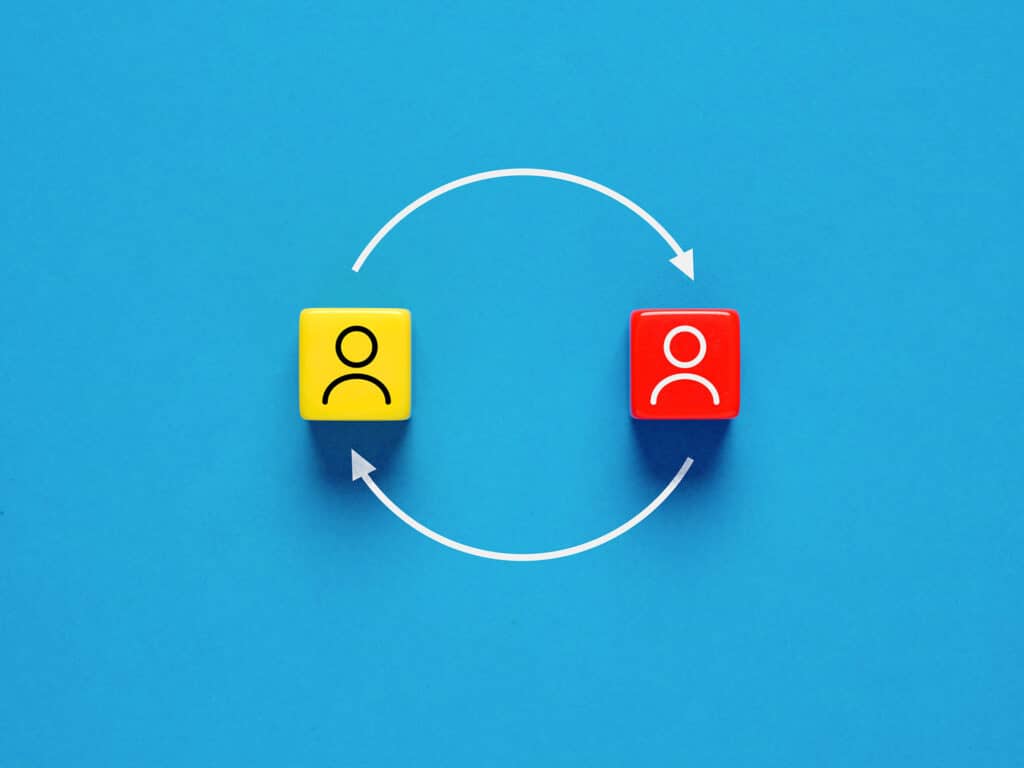What does employee engagement mean?
Employee engagement describes the level of emotional commitment, motivation and dedication that an employee feels towards their company and their tasks.
Committed employees are willing to go above and beyond the minimum to contribute to the success of the company.
They identify with the company’s goals and values and are often proactive in the way they work.
Benefits of high employee engagement
Before we look at strategies to increase engagement, let’s take a look at the benefits for companies:
1st benefit: Higher productivity
Engaged employees are more productive because they approach their tasks with greater enthusiasm and energy.
2nd advantage: Lower staff turnover
Companies with a high level of employee engagement have lower turnover rates and can retain top talent for longer.

3rd advantage: Improved customer loyalty
Engaged employees have a positive impact on customer service, which leads to higher customer satisfaction and loyalty.
4th advantage: Creativity and innovation
Employees who identify with the company are more likely to come up with new ideas and contribute to continuous improvement.
Strategies for increasing employee engagement
Method 1: Communicate clear goals and visions
Employees want to know where the company is heading and what role they themselves play in this.
A clear and inspiring vision helps them to understand their contribution to the bigger picture.
Communicate the company’s goals regularly and show how individual performance contributes to achieving them.
Tip:
Make sure company goals are SMART - specific, measurable, achievable, relevant and time-bound.
2nd method: Promoting employee development

Invest in the further development of your employees through training, workshops and mentoring programs.
Employees who feel that their career is being supported within the company are more motivated and committed.
Tip:
Offer individual development plans that are tailored to each employee's career goals.
3rd method: Showing recognition and appreciation
A simple but often overlooked way to increase engagement is to recognize good performance.
Show appreciation for your employees’ hard work and celebrate their successes, big or small.
Tip:
Implement a reward system that considers not only monetary incentives, but also social recognition such as “employee of the month” or special thank yous.
4th method: Promoting open communication
Transparent communication is the key to an engaged workforce.
Create a culture where employees can freely express their opinions without fear of negative consequences.
Feedback should flow both ways so that employees feel taken seriously and heard.
Tip:
Introduce regular feedback meetings and use digital tools to facilitate the exchange between managers and employees.
5th method: Supporting work-life balance

A good work-life balance is crucial to prevent stress and burnout.
Flexible working hours, home office options and health promotion measures help employees to feel comfortable and perform at their best.
Tip:
Implement stress management programs and promote a company culture where breaks and time off are accepted and valued.
6th method: Promoting teamwork and collaboration
Successes achieved together strengthen the sense of community and the commitment of employees.
Promote a culture of collaboration and support team-based projects.
Employees should feel that they are part of a strong team working together towards a common goal.
Tip:
Organize regular team-building events and create opportunities for cross-departmental collaboration.

7th method: Promote autonomy and personal responsibility
Give employees the opportunity to work independently and take responsibility for their tasks.
If employees feel that they are trusted and can develop their skills, their motivation and commitment will increase.
Tip:
Avoid micromanagement and encourage employees to find creative solutions and make decisions independently.
Measuring and evaluating employee engagement
To check whether your efforts to increase employee engagement are successful, you should regularly measure the engagement of your employees.
Use surveys, appraisal interviews and analysis tools to get a comprehensive picture.
Identify areas where there is potential for improvement and adjust strategies accordingly.
Possible measurement methods:
1st method: Engagement surveys
Short, regular surveys help to measure the mood and satisfaction of employees.
2nd method: Feedback meetings
Direct discussions offer the opportunity to clarify individual concerns and respond specifically to requests for improvement.
3rd method: Key figures
Analyze data on absences, turnover rates and productivity to identify trends.
Conclusion
Employee engagement is a long-term process that requires continuous attention and investment.
Companies that actively invest in the motivation and satisfaction of their employees not only create a more productive working environment, but also strengthen their competitive position.
Through clear communication, targeted recognition, development opportunities and a strong company culture, you can sustainably increase employee engagement and ensure your company’s long-term success.
Start inspiring and motivating your employees today – the benefits will quickly be reflected in your company’s bottom line!




